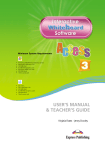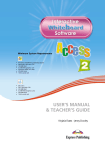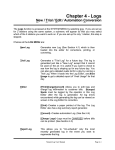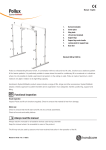Download 8 - Cybernet.be
Transcript
Engineering (from: Cambridge English for Engineering, Professional English, Unit 1, p6, Mark Ibbotson, 2010) Unit 1: Technology in use • Describing technical functions and applications • Explaining how technology works • Emphasising technical advantages • Simplifying and illustrating technical explanations Describing technical functions and applications 1a In pairs, think about two or three products you use regularly and discuss the following questions. • What are the main functions of the products? (What do they do?) • What are their different applications? (What are they used for?) 1b What do you know about Global Positioning System (GPS) devices? In pairs, describe their main function, and give some examples of different applications of GPS devices. 2a (tapescript 1.1) Paula, a design engineer for a GPS manufacturer, is discussing product development with Jose, a senior manager new to the company. Listen to the conversation and complete the following notes. • the primary application of GPS (1) ____________________ • associated applications Tracking systems for (2) ____________________ Tracking systems for (3) ____________________ • more creative features (4) ____________________ alarms (5) ____________________ buttons • not technical innovations (6) ____________________ the technology 2b Complete the following extracts from the discussion with words that come from use. 1 Then you've got associated applications, ____________________ that are related to navigating. 2 …tracking systems you can ____________________ for monitoring delivery vehicles. 3 …from the end-____________________ point of view, accuracy is no longer the main selling point. Most devices are accurate enough. The key is to make them more ____________________. 3a Match the GPS applications (1-6) to the descriptions (a-f). 1 topographical surveying a navigation and safety at sea 2 geological exploration b setting out positions and levels of new structures 3 civil engineering c mapping surface features 4 avionics equipment d applications in mining and the oil industry 5 maritime applications e highway navigation and vehicle tracking 6 GPS in cars and trucks f air traffic control, navigation and autopilot systems 3b In pairs, practise explaining the applications of GPS in Exercise 3a to a colleague who has limited knowledge of the devices using the following phrases. used for –ing / used to / useful for / another use / a similar use 4a Complete the following extracts from the conversation by underlining the correct words. 1 ... there's a setting on the GPS that allows/prevents it to detect the movement. 2 … an alarm sounds to warn you, and allows/prevents the boat from drifting unnoticed 3 ... and enables/ensures that you don't lose track of where you were, which then enables/ensures you to turn round and come back to the same point ... 4b Complete the following extract from the user's manual of a GPS device using the verbs in Exercise 4a. Sometimes, more than one answer is possible. INTRODUCTION The core function of your GPS receiver is to (1)____________________ you to locate your precise geographical position. To (2) ____________________ the device to function, it receives at least three signals simultaneously from the GPS constellation - 30 dedicated satellites which (3)____________________ receivers can function anywhere on earth. To (4)____________________ extremely precise positioning and (5)____________________ errors from occurring due to external factors, this device is designed to receive four separate signals (see enhanced system accuracy on page 18). 5 In pairs, explain the main functions and applications of a product made by your company or a product you know about. Student A, you are an engineering manager; Student B, you are a new employee. Use the language from this section and the phrases in the box. Swap roles and practise again. I see. So ... / OK. In other words... / So you mean... Explaining how technology works 6a In pairs, look at the picture and discuss the following questions. • How do you think a space elevator would work? • What could it be used for? • What technical challenges would it face? • How seriously do you think the concept of space elevators is being taken at present? 6b Read the following article and compare it to your answers in Exercise 6a. Space elevators: preparing for takeoff In his 1979 novel, The Fountains of Paradise, Arthur C Clarke wrote about an elevator connecting the earth's surface to space. Three decades later, this sciencefiction concept is preparing to take off in the real world. NASA has launched the Space Elevator Challenge, a competition with a generous prize fund, and several teams and companies are working on serious research projects aimed at winning it. As its name suggests, a space elevator is designed to raise things into space. Satellites, components for space ships, supplies for astronauts in space stations, and even astronauts themselves are examples of payloads that could be transported into orbit without the need for explosive and environmentally unfriendly rockets. However, the altitude of orbital space - a colossal 35,790 km above the earth - is a measure of the challenge facing engineers. How could such a height be reached? The answer is by using an incredibly strong and lightweight cable, strong enough to support its own weight and a heavy load. The design of such a cable is still largely theoretical. This would be attached to a base station on earth at one end and a satellite in geostationary orbit (fixed above a point on the equator) at the other. Lift vehicles would then ascend and descend the cable, powered by electromagnetic force and controlled remotely. 6c Match the verbs (1-9) from the text in Exercise 6b to the definitions (a-i). 1 connecting a carried (objects, over a distance) 2 raise b hold something firmly I bear its weight 3 transported c climb down 4 support d provided with energy I moved by a force 5 attached e joining 6 ascend f driven I have movement directed 7 descend g fixed 8 powered h climb up 9 controlled i lift I make something go up 7a James, an engineer, is giving a talk on space elevators. Complete his notes using the correct form of the verbs (17) in Exercise 6c. Space elevators • Challenge of (1) connecting a satellite to earth by cable is significant. • To (2)____________________ its own weight, and be securely (3)____________________ at each end, cable would need phenomenal strength-to-weight ratio. • How could vehicles be (4)____________________ into space, up cable? • Self-contained energy source problematic, due to weight (heavy fuel or batteries required to (5)____________________ vehicle). • Two possible ways round problem: 1 Transmit electricity wirelessly. But technique only at research stage. 2 Solar power. But would only allow vehicle to (6)____________________ slowly. Not necessarily a problem, as car could be controlled remotely, allowing it to (7)____________________ payloads unmanned. 7b (tapescript 1.2) Listen to part of James' talk and check your answers in Exercise 7a. 7c What kinds of word are missing from the notes? In pairs, compare the audioscript on page 86 with the notes in Exercise 7a. 8a Some space elevator designs propose an offshore base station. In pairs, discuss how such a system might work using words in Exercise 6c. What advantages might an offshore base have compared with a land base? 8b (tapescript 1.3) James goes on to discuss offshore base stations. Listen to the talk and answer the following questions. 1 How would an offshore base station be supported? 2 What would the function of its anchors be? 3 How would payloads reach the base station? 4 What problem would a mobile base station help to prevent? 5 What would the procedure be if there was an alert? 9a You are members of a space elevator research team designing a concept for offshore base stations. In pairs, analyse the notes below, which were made during a briefing given by your manager. Imagine you are giving a presentation. Begin by reading out the abbreviated notes in full. Offshore base station – Anchoring & propulsion issues Anchoring system Winch load on cable will be huge. What implication for anchoring system? Base will need to be moved continually. sometimes urgently What temp system could be used to hold base in position? Base in shallow water near coast or deep water further offshore? Choice will have impact on design of anchor system Propulsion system Will weight of cable. allow base to be moved by own propellers? Or more powerful system for propulsion and control necessary? E.g. extern. power source? 9b In pairs, discuss the questions raised in the notes and think of some suitable solutions for the anchoring system and the propulsion system. At this stage, these should be overall concepts, not detailed designs. Remember to make notes. 9c In small groups, take turns to give a short talk using your notes to explain how the systems work, in general terms. Imagine you are speaking to a small group of colleagues, including your manager. 9d Write two or three paragraphs to summarise your talk. These will be included in your manager's longer report on offshore base stations. Key to the exercises 2a 1 navigation 2 (monitoring) delivery vehicles 3 (finding) stolen cars 4 drift 5 man overboard 6 innovative uses of 2b 1 uses 2 use 3 user's; useful 3a 1c 2d 3b 4f 5a 6e 4a 1 allows 2 prevents 3 ensures; enables 4c 1 allow/enable 2 allow/enable 3 ensure 4 allow/enable 5 prevent 6c 2i 3a 4b 5g 6h 7c 8d 9f 7a 2 support 3 attached 4 raised 5 power 6 ascend 7 transport 7c The notes are missing articles (a/an, the) and some auxiliary verbs (e.g. be). 8a See audioscript 1.3 8b 1 By a floating structure 2 To attach the base to the sea bed 3 Ships would carry them 4 Collisions between the cable and space debris 5 The anchors would be raised and the station would be moved. 9a Suggested answer The anchoring system The wind loads on the cable will be huge. What are the implications for the anchoring system? The base will need to be moved continually and sometimes urgently. What temporary system could be used to hold the base in position? Should the base be In shallow water near the coast, or in deep water further offshore? The choice will have an impact on the design of the anchor system. The propulsion system Will the weight of the cable allow the base to be moved by its own propellers or will a more powerful system for propulsion and control be required? For example, an external power source. 9b Suggested answers Anchor system It will be possible to anchor the base more securely in shallow water, near the coast. A permanent anchor structure could be built on the ocean bed, In shallow water. The base station could then be fixed securely to it with cables. If several anchor structures are built at different locations along the coast, the base station can be moved between them. Propulsion system Tugs (powerful boats used for pulling ships) could be used as an external power source. However. the base station could be driven by its own propellers. The large, powerful engines needed to propel it would be heavy, but that isn't necessarily a disadvantage, as extra mass, and therefore extra inertia, would help to make the base more stable. Tapescripts 1.1 Paula: Obviously navigation is the primary application of most GPS devices. Jose: Sure. Paula: Then you've got associated applications, uses that are related to navigating, such as tracking systems you can use for monitoring delivery vehicles and finding stolen cars, that kind of thing. Jose: Mm. Paula: And then there are more creative features. A good example would be on a boat GPS, you get drift alarms. So if the anchor starts to drag and the boat starts moving, there's a setting on the GPS that allows it to detect the movement, and an alarm sounds to warn you, and prevents the boat from drifting unnoticed. Jose: I see. Paula: Or another example on boat systems is man overboard buttons. So if you're sailing along and someone falls into the sea, you hit a button, which logs the position and ensures that you don't lose track of where you were, which then enables you to turn round and come back to the same point and find the person. Jose: Right. Paula: So, these are the kinds of applications we want to develop, more specialised, and more creative. Jose: So, effectively, you're not talking about technical innovations. What you're really looking for is innovative ways of actually using the technology, Paula: Precisely. Because these days, from the end-user's point of view, accuracy is no longer the main selling point. Most devices are accurate enough. The key is to make them more useful. So in terms of development, that's the kind of . 1.2 James: The engineering Challenge of connecting a satellite to earth using a cable is, obviously, significant. In order to support its own weight, and be securely attached at each end, the cable would require a phenomenal strength-toweight ratio. Carbon nanotube materials might, one day, be up to the job. And I'll talk about those in detail later on. How could vehicles be raised into space, up the cable? Well, using a self-contained energy source would be problematic, due to the weight of fuel or batteries required to power the vehicle. There are two possible ways round this problem: transmitting electricity wirelessly, or using solar power. The first technique is only in the early stages of research. The second would allow the vehicle to ascend only very slowly, though this wouldn't necessarily be a problem, as the car could be controlled remotely, allowing it to transport payloads as an unmanned vehicle. 1.3 James: The offshore base station would be supported by a floating structure, which could be attached to the sea bed by anchors. Payloads could be carried from the shore to the station by ship before being lifted into orbit. The main advantage of a floating mobile station, rather than a fixed base on land, would be to help reduce the risk of a collision between the cable and one of the many lumps of space debris, such as redundant satellites, that litter orbital space. Based on careful monitoring of debris movements, in the case of an alert the station's anchors could be raised and the station could be moved, driven by propellers, to a new location out of harm's way.














